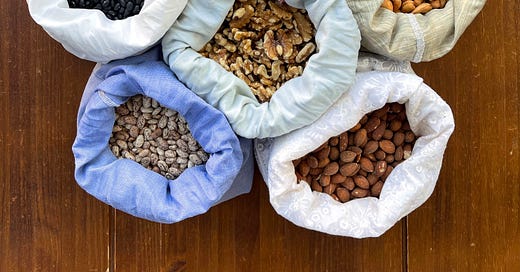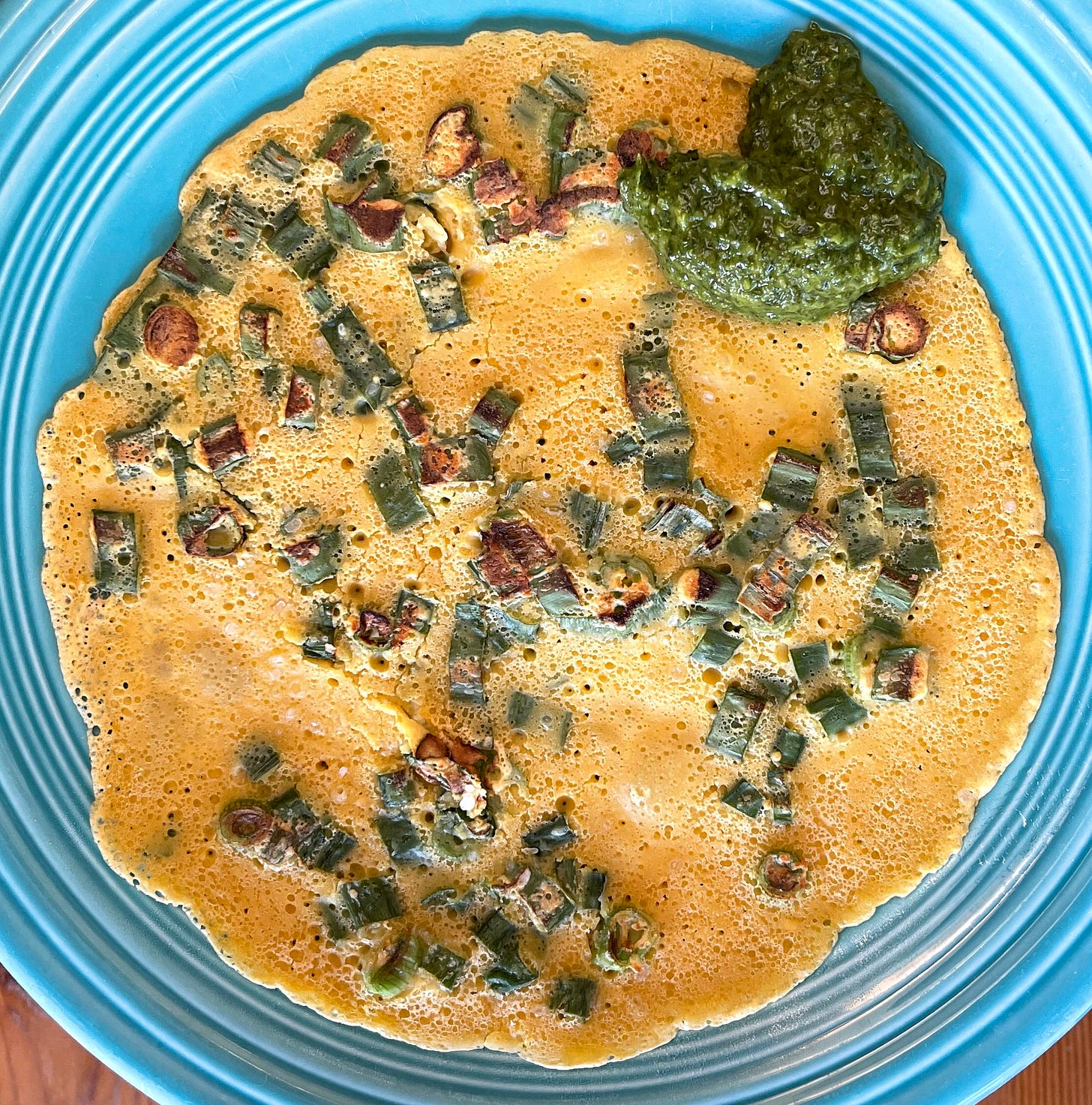I’ve done the math for a couple of these dishes in the past and the ingredients certainly cost more today. All the more reason to make sure we eat all the food we buy! Not wasting food can save families hundreds of dollars (or more) every year and truly requires zero sacrifice, just a small shift in mindset.
Each frugal dinner in this newsletter serves four. I based the prices for these five meals on what I paid this past weekend at the farmers’ market and what I saw on Instacart, where I looked up the prices at two local stores. One sells bulk foods and the other—a family-owned small business with very good quality—charges more than chain supermarkets. Also keep in mind that I picked organic food for the most part. I wanted to err on the side of higher prices for these totals.
Had I done my research at a discount grocery store or chosen non-organic ingredients, these dishes would have cost less. So these prices are a bit inflated—but not due to inflation alone.
Not-too-Spicy Black Beans
I make this dish with dry beans. They cost less than canned (usually) and taste much better. In addition to the beans, you’ll need fat, an onion and some garlic, jalapeños, salt, lime juice and cilantro. Serve the beans with rice or the sourdough discard tortillas in my cookbook. Yum!
Estimated cost: $11.98 for four
This price includes 2 cups of cooked rice. You’ll have enough money left to buy a head of Romaine to make a salad. Put that extra cilantro into the dressing or add some of it to the salad to ensure you eat it more of it. And if you grow your own cilantro, you’ll save $1.50 (give or take).
Go here for the Not-Too-Spicy Black Beans recipe.
Grateful-for-What-I-Have Vegetable Fried Rice
Not only does this recipe save you money—even with my very expensive farmers’ market eggs from pasture-raised hens which I happily pay extra for—it saves time if you’ve already cooked the rice. So if the black beans above sound appetizing, you may want to cook extra rice for those so you’ll have the rice prepped for this. It works much better with slightly dried-out rice rather than freshly cooked. Use whatever vegetables you have on hand so they fill tummies, not trash.
Estimated cost: $14.49 for four
I didn’t include green onions in this recipe. I grow my own and was shocked to discover they cost $2.89 for an organic bunch (non-organic cost less, 99 cents). If you do buy the green onions, regrow them in a pot of soil placed indoors or out or plant them directly in soil outside. Go here for more info.
Go here for the fried rice recipe.
Sourdough Discard Pizza
The sourdough discard pizza on my blog has consistently been a top post since I first posted it in 2020. It renders a chewy crust with a soft interior and puts a large dent in your discard jar if you keep a sourdough starter.
Now, if you top this pizza with loads of fancy cheese, it will cost more than $16. But think of the cheese as a condiment—you need only so much for flavor. Or you can forgo the cheese altogether and use homemade cultured cashew “cheese.”
Estimated cost: $14.82
To arrive at this price, I doubled the pizza dough recipe, used an entire batch of cultured cashew cheese and for my toppings, chose tomatoes (1 per pizza), red bell pepper strips (1/4 of a bell pepper per pizza) and one caramelized onion divided among the four pizzas.
I occasionally make the cheese with sunflower seeds—they cost much less. I do prefer the cashews but wouldn’t turn down the sunflower version either. (Similarly, my student-daughter makes homemade Nutella with economical sunflower seeds rather than hazelnuts.)
Go here for the pizza dough recipe.
Borschuka: Eggs Poached in Borscht, Inspired by Shakshuka
I love borscht—a Ukrainian sour soup made with beets (for the red version). I also love shakshuka—a North African and Middle Eastern dish consisting of eggs poached in tomatoes. A few months ago, after putting away a pot of leftover borscht, I thought to myself, why not poach eggs in it like shakshuka? And why not call it borschuka? (Poach eggs in almost any soup to add protein or to merely revive leftovers.)
As you peel the beets and cut off the ends, save those to make beet kvass, a savory drink filled with live cultures that can benefit your gut. Beet kvass costs about $8 for a small bottle in the store—if you can find it—but you can make the same amount with your beet scraps essentially for nothing. The drink contains just beets, salt and water. The scrappy beet kvass recipe appears just under the borschuka recipe on my website.
Estimated cost: $15.89 for four
My original recipe serves three so I increased that to serve four for the math (be sure to adjust the recipe accordingly). I omitted the dill because I often forget to buy it or can’t find it and wanted to keep this under $16. (But the dill tastes very nice sprinkled on top.) Go here for the borschuka recipe.
Besan Chilla: Easy 5-Ingredient Gram Flour Pancakes
I am obsessed with these! They taste like omelets but contain no eggs. These rich thin pancakes contain a handful of simple ingredients (isn’t that the trick to good food?): besan, vegetables, spices, salt and water. I love them made with green onions and tomatoes but use whatever vegetables I have on hand.
Besan—also known as gram flour (not graham flour!)—is made of finely ground split roasted chickpeas and differs from chickpea flour, which is made of ground whole chickpeas. I do make these with chickpea flour as well but prefer them with besan. If you use chickpea flour, add the water gradually rather than all at once to avoid rendering lumps in the batter.
Estimated cost: $9.88 for four (includes fresh cilantro chutney)
I tripled the recipe on my blog and included more add-ins than I have listed there—one large yellow onion, 3 medium tomatoes, 2 jalapeños, turmeric and cumin. I also included the cilantro chutney. If you have lots of cilantro left over from the black beans in the first recipe on this list, use it for chutney.
Go here for the besan chilla recipe. (Keep in mind that I tripled it here for four people!)
Upcoming workshops
Start a Sourdough Starter (free)
Thursday, August 4th, 10am PDT/1pm EDT
All you need to start and nurture a lively sourdough starter culture are flour, water, time and a bit of know-how. In this Zoom class, I’ll show you how to start a starter culture and how to keep it alive. Bring your questions and I’ll answer as many as I can after the demo. If you’d like to make a starter during the class, please bring the materials listed here. Or just sit back and listen during the workshop if you prefer.
Raise a Glass for Climate Action: Ginger Beer Workshop Fundraiser (pay-what-you-feel)
Thursday, August 18th, 4pm PDT/7pm EDT
To make fantastic ginger beer, you need only water, sugar and organic ginger. In this workshop, together we’ll make a ginger bug, a type of starter for natural sodas, and the most crucial part of the ginger beer-making process. After we make our ginger bugs and I explain how to care for them, I’ll show you how to make the ginger beer. If you already have a mature ginger bug, make ginger beer during the workshop.
All proceeds for this workshop go to the climate-focused organization you choose from the list on my website.
My cookbook has been shortlisted for a Taste Canada award! Here’s another frugal recipe on the Taste Canada website, Frugal Fennel-Frond Pesto and Pasta, from my book. Learn more about my book here.







Love all the ideas, but I am commenting because I finally read a ferment recipe that sounds simple enough for me to try without fear! Your Beet Kvass! I love beets, and cook them frequently, often just steaming and eating most of the peel. But I never eat the top, nor the big root, and truth be told, don't enjoy the peel - I just eat it because my grandmother explained how many minerals are in the veggie skins! So Thank You Much for this inspiring idea, and the recipe! I will make it soon!